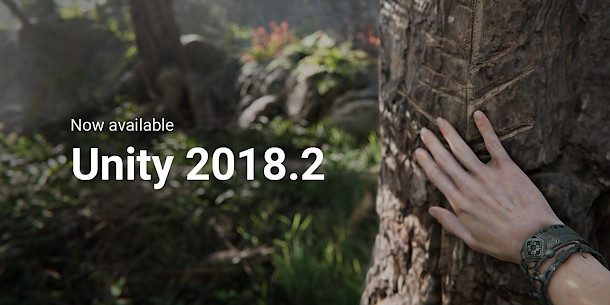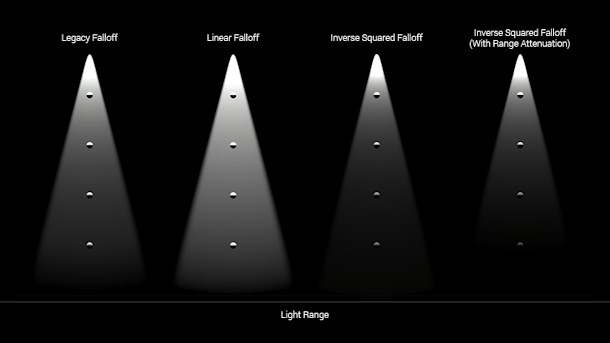Unity Technologies releases Unity 2018.2

Unity Technologies has released Unity 2018.2, the second of this year’s cycle of three updates to the game engine and development environment, following the release of Unity 2018.1 in May.
The update adds support for texture mipmap streaming, a new physical camera model and SVG importer; and extends the Scriptable Render Pipeline, Shader Graph, Progressive Lightmapper and particles tools.
However, one feature originally announced for the 2018.2 release hasn’t made it in – the new GPU lightmapper is now officially back to being “in development”, with no confirmed release date.
Updates to the Scriptable Render Pipeline and Shader Graph
Unity 2018.2 builds on several of the key features introduced in the previous release: notably, the new Scriptable Render Pipeline and the Shader Graph.
The former now renders faster on the CPU, particularly on projects that use PBR workflows, while the readymade High Definition Render Pipeline (HDRP) gets new features including support for volumetrics.
The Shader Graph now supports both the HDRP with both PBR and Unlit Master nodes.
There are also several new node types in the Shader Graph, including two new gradient nodes, support for Unity’s Texture2D and Texture3D arrays, and LOD functionality for 2D textures.
Support for texture mipmap streaming, new physical camera model, new 2D tools
Entirely new features this time around include support for streaming texture mipmaps into memory on demand, reducing texture memory usage and improving game performance.
Users can specify which textures are streamed, and which mipmap levels are actually loaded.
The update also introduces a new physical camera model. It works with the standard Unity Camera object, and makes it possible to specify properties including Focal Length, Lens Shift and Sensor Size.
Presets matching common real-world camera types are available as a drop-down, and it is possible to import cameras from Maya and “other compatible DCCs” preserving their physical properties.
There are also several new 2D tools, including preview packages for Pixel Perfect Camera, which handles scaling calculations when changing screen resolution, and a self-explanatory SVG importer.
Users can also now create hexagonal tilemaps for strategy games, as well as the existing square tilemaps.

Updates to the CPU lighmapper, but no news of the GPU version
Progressive Lightmapper, Unity’s CPU-based lightmapping system, also gets an update, including more options for computing falloff, and the option for instanced objects to share albedo and emissive maps.
However, the bigger news on that front is that the new GPU-based lightmapper, announced at GDC and originally scheduled for Unity 2018.2, has been delayed, and now has no official release date.
In the online roadmap, it has now been moved to the Development category for projects whose timelines are “long or uncertain”.
Other changes: updates to particle sysetms, support for 4K monitors and Vulkan
Other changes in Unity 2018.2 include improvements to particle systems, including a new ‘solo mode’ for selected particles, plus support for linear colour space, and up to eight UVs.
For users with 4K monitors, the Unity Editor also now supports High-DPI scaling on Windows and Linux, and support for per-monitor display scale factors on Windows.
The Editor also gets experimental support for Vulkan on Windows and Linux
Programmers get updates to the C# Job System, Entity Component System and Burst Compiler introduced in Unity 2018.1, including support for burst compiling on Windows, macOS and Linux.
It is also now possible to use .java source files in Unity project plugin folders and have them compile automatically to Android APKs without the need to use Android Studio.
Finally, the release deprecates UnityScript, Unity’s original scripting language, in favour of C#; and deprecates support for the .NET scripting backend in favour of IL2CPP.
New Google Play Instant plugin, plus updates to standalone tools Unity Hub and Recorder
Outside of the core application, there is a new Google Play Instant plugin for converting Unity projects into Google Play’s new instant app format. The plugin is currently available in beta on GitHub.
Unity Hub, the new desktop app for managing Unity projects and multiple parallel installations of Unity Editor, is coming up to a 1.0 release, which will add support for project templates and custom install locations.
Recorder, designed for recording stills or movies within Unity Editor, is also coming up to a 1.0 release, introducing a new UI, new presets, animation export in FBX format, and support for multi-format exports.
Unity’s blog post doesn’t give a shipping date for either 1.0 version, but presumably both are imminent.
Pricing and availability
Unity 2018.2 is available for Windows 7+ and Mac OS X 10.11+ on a rental-only basis.
Free Personal subscriptions have a non-editable splash screen and can be used by anyone with revenue of up to $100,000/year. Paid Plus and Pro plans cost $35/seat/month and $125/seat/month respectively.
Read a full list of new features in Unity 2018.2 on Unity Technologies’ blog
